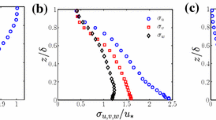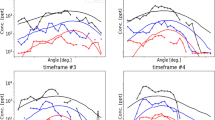Abstract
A new approach is proposed to predict concentration fluctuations in the framework of one-particle Lagrangian stochastic models. The approach is innovative since it allows the computation of concentration fluctuations in dispersing plumes using a Lagrangian one-particle model with micromixing but with no need for the simulating of background particles. The extension of the model for the treatment of chemically reactive plumes is also accomplished and allows the computation of plume-related chemical reactions in a Lagrangian one-particle framework separately from the background chemical reactions, accounting for the effect of concentration fluctuations on chemical reactions in a general, albeit approximate, manner. These characteristics should make the proposed approach an ideal tool for plume-in-grid calculations in chemistry transport models. The results are compared to the wind-tunnel experiments of Fackrell and Robins (J Fluid Mech, 117:1–26, 1982) for plume dispersion in a neutral boundary layer and to the measurements of Legg et al. (Boundary-Layer Meteorol, 35:277–302, 1986) for line source dispersion in and above a model canopy. Preliminary reacting plume simulations are also shown comparing the model with the experimental results of Brown and Bilger (J Fluid Mech, 312:373–407, 1996; Atmos Environ, 32:611–628, 1998) to demonstrate the feasibility of computing chemical reactions in the proposed framework.
Similar content being viewed by others
References
Alessandrini A, Ferrero E (2009) A hybrid Lagrangian-Eulerian particle model for reacting pollutant dispersion in non-homogeneous non-isotropic turbulence. Physica A 388: 1375–1387
Arya SP (1999) Air pollution meteorology and dispersion. Oxford University Press. New York, 310 pp
Brown RJ, Bilger RW (1996) An experimental study of a reactive plume in grid turbulence. J Fluid Mech 312: 373–407
Brown RJ, Bilger RW (1998) Experiments on a reacting plume 1. Conventional concentration statistics. Atmos Environ 32: 611–628
Cassiani M, Giostra U (2002) A simple and fast model to compute concentration moments in a convective boundary layer. Atmos Environ 36: 4717–4724
Cassiani M, Franzese P, Giostra U (2005a) A PDF micromixing model of dispersion for atmospheric flow Part I: development of the model, application to homogeneous turbulence and to neutral boundary layer. Atmos Environ 39(8): 1457–1469
Cassiani M, Franzese P, Giostra U (2005b) A PDF micromixing model of dispersion for atmospheric flow. Part II: application to convective boundary layer. Atmos Environ 39(8): 1471–1479
Cassiani M, Radicchi A, Giostra U (2005c) Probability density function modelling of concentration fluctuation in and above a canopy layer. Agric For Meteorol 133: 153–165
Cassiani M, Radicchi A, Albertson JD, Giostra U (2007a) An efficient algorithm for scalar PDF modelling in incompressible turbulent flow; numerical analysis with evaluation of IEM and IECM micro-mixing models. J Comput Phys 223(2): 519–550
Cassiani M, Radicchi A, Albertson JD (2007b) Modelling of concentration fluctuations in canopy turbulence. Boundary-Layer Meteorol 122(3): 655–681
Cassiani M, Vinuesa JF, Galmarini S, Denby B (2010) Stochastic fields method for sub-grid scale emission heterogeneity in mesoscale atmospheric dispersion models. Atmos Chem Phys 10: 267
Chock DP, Winkler SL (1994a) A particle grid air quality modeling approach, 1. The dispersion aspect. J Geophys Res 99: 1019–1031
Chock DP, Winkler SL (1994b) A particle grid air quality modeling approach, 2. Coupling with chemistry. J Geophys Res 99: 1033–1041
De Arellano JV-G, Dosio A, Vinuesa J-F, Holtslag AAM, Galmarini S (2004) The dispersion of chemically reactive species in the atmospheric boundary layer. Meteorol Atmos Phys 87: 23–38
Durbin PA (1980) A stochastic model of two-particle dispersion and concentration fluctuations in homogeneous turbulence. J Fluid Mech 100: 279–302
Fackrell JE, Robins AG (1982) Concentration fluctuations and fluxes in plumes from point sources in a turbulent boundary layer. J Fluid Mech 117: 1–26
Flesch TK, Wilson JD (1992) A two dimensional trajectory simulation model for non Gaussian inhomogeneous turbulence within plant canopies. Boundary-Layer Meteorol 61: 349–374
Fox RO (2003) Computational models for turbulent reacting flows. Cambridge University Press, Cambridge, p 419 pp
Franzese P, Luhar AK, Borgas MS (1999) An efficient Lagrangian stochastic model of vertical dispersion in the convective boundary layer. Atmos Environ 33: 2337–2345
Franzese P (2003) Lagrangian stochastic modeling of a fluctuating plume in the convective boundary layer. Atmos Environ 37: 1691–1701
Franzese P, Cassiani M (2007) A statistical theory of turbulent relative dispersion. J Fluid Mech 571: 391–417
Galmarini S, Vilà à-Gueraude Arellano J, Duynkerke PG (1995) The effect of micro-scale turbulence on the reaction rate in a chemically reactive plume. Atmos Environ 29: 87–95
Galmarini S, Vinuesa JF, Martilli A (2008) Modeling the impact of sub-grid scale emission variability on upper-air concentration Atmos. Chem Phys 8: 141–158
Gardiner CW (1983) Handbook of stochastic methods for physics chemistry and the natural sciences. Springer, New York, 442 pp
Garmory A, Richardson ES, Mastorakos E (2006) Micromixing effects in a reacting plume by the stochastic fields method. Atmos Environ 40: 1078–1091
Gillani NV, Godowitch JM (1999) Plume-in-grid treatment of major point source emissions, in Science Algorithms of the EPA Models-3 Community Multiscale Air Quality (CMAQ) Modeling System, chap 9, 9-1– 9-39, EPA-600/R-99/030, U.S. Environmental Protection Agency, Washington, D.C.
Karamchandani P, Santos L, Sykes I, Zhang Y, Tonne C, Seigneur C (2000) Development and evaluation of a state-of-the-science reactive plume model. Environ Sci Technol 34: 870–880
Karamchandani P, Signeur C, Vijayaraghavan K (2002) Development and application of a state-of-the-science plume-in-grid model. J Geophys Res 107(D19): 4403
Kumar N, Russel AG (1996) Development of a computationally efficient, reactive subgrid-scale plume model and the impact in the northeastern United States using increasing levels of chemical detail. J Geophys Res 101(16): 737–16,744, 1996b
Legg BJ, Raupach MR, Coppin PA (1986) Experiments on scalar dispersion within a model plant canopy. Part III: an elevated line source. Boundary-Layer Meteorol 35: 277–302
Li JD, Bilger RW (1996) The diffusion of conserved and reactive scalars behind line sources in homogeneous turbulence. J Fluid Mech 318: 339–372
Luhar AK, Hibberd MF, Borgas MS (2000) A Skewed meandering plume model for concentration statistics in the convective boundary layer. Atmos Environ 34: 3599–3616
Monin AS, Yaglom AM (1971) Statistical fluid mechanics, vol 1. MIT Press, Cambridge, p 769 pp
Mortarini L, Franzese P, Ferrero E (2009) A fluctuating plume model for concentration fluctuations in a plant canopy. Atmos Environ 43(4): 921–927
Middleton DR, Jones AS, Redington AL, Thomson DJ, Sokhi RS, Luhana L, Fisher BEA (2008) Lagrangian modelling of plume chemistry for secondary pollutants in large industrial plumes. Atmos Environ 42: 415–427
Poggi D, Katul GG, Cassiani M (2008) On the anomalous behavior of the Lagrangian structure function similarity constant inside dense canopies. Atmos Environ 42: 1842124231
Pope SB (1985) PDF methods for turbulent reactive flows. Prog Energy Combust Sci 11: 119–192
Pope SB (1994) Lagrangian PDF methods for turbulent flows. Ann Rev Fluid Mech 26: 23–63
Pope SB (1998) The vanishing effect of molecular diffusivity on turbulent dispersion: implications for turbulent mixing and the scalar flux. J Fluid Mech 359: 299–312
Pope SB (2000) Turbulent flows. Cambridge University Press, UK, p 771 pp
Postma JV, Wilson JD, Yee E (2011a) Comparing two implementations of a micromixing model. Part I: Wall shear-layer flow. Boundary-Layer Meteorol. 140: 207–224
Postma JV, Wilson JD, Yee E (2011b) Comparing two implementations of a micromixing model. Part II: canopy flow. Boundary-Layer Meteorol 140: 225–241
Sawford BL (2004) Micro-mixing modelling of scalar fluctuations for plumes in homogeneous turbulence. Flow Turbul Combust 72: 133–160
Stein AF, Lamb DF, Draxler RR (2000) Lagrangian modelling of plume chemistry for secondary pollutants in large industrial plumes. Atmos Environ 34: 4361–4372
Stohl A, Forster C, Frank A, Seibert P, Wotawa G (2005) The Lagrangian particle dispersion model FLEXPART version 6.2. Atmos. Chem Phys 5: 2461–2474
Thomson DJ (1987) Criteria for the selection of the stochastic models of particle trajectories in turbulent flows. J Fluid Mech 180: 529–556
Thomson DJ (1990) A stochastic model for the motion of particle pairs in isotropic high-Reynolds-number turbulence, and its application to the problem of concentration variance. J Fluid Mech 210: 113–153
Thomson DJ (1996) The second-order moment structure of dispersing plumes and puffs. J Fluid Mech 320: 305–329
Valiño L (1998) A field Monte Carlo formulation for calculating the probability density function of a single scalar in a turbulent flow. Flow Turbul Combust 60: 157–172
Villermaux J, Falk L (1994) A generalized mixing model for initial contacting of reactive fluids. Chem Eng Sci 49: 5127–5140
Vinuesa JF, Galmarini S (2009) Turbulent dispersion of non-uniformly emitted passive tracers in the convective boundary layer. Boundary-layer Meteorol 133: 191–210
Weinroth E, Stockwell W, Koracin D, Kahyaoglu-Koracin J, Luria M, McCord T, Podnar D, Gertler A (2008) A hybrid model for ozone forecasting. Atmos Environ 42: 7002–7012
Wilson JD, Sawford BL (1996) Review of Lagrangian stochastic models for trajectories in the turbulent atmosphere. Boundary-layer Meteorol 78: 191–210
Wilson JD, Yee E (2007) A critical examination of the random displacement model of turbulent dispersion. Boundary-layer Meteorol 125: 399–416
Author information
Authors and Affiliations
Corresponding author
Rights and permissions
About this article
Cite this article
Cassiani, M. The Volumetric Particle Approach for Concentration Fluctuations and Chemical Reactions in Lagrangian Particle and Particle-grid Models. Boundary-Layer Meteorol 146, 207–233 (2013). https://doi.org/10.1007/s10546-012-9752-3
Received:
Accepted:
Published:
Issue Date:
DOI: https://doi.org/10.1007/s10546-012-9752-3




